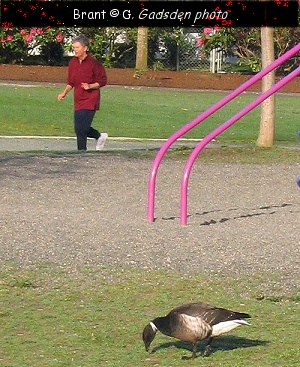|
Sardis Pond
by Gord Gadsden
Sardis Pond is a City of Chilliwack park located in Sardis in the middle of a residential area. It provides a short walk around the pond and two small playgrounds for children. It is open to fishing for children and seniors and is stocked by the local trout hatchery. This small area has always been a busy place for birds, especially waterfowl. A respectable number of bird species have been seen here even with the heavy residential area that surrounds the park. Recent modifications by the City removed an island that was inaccessible to the public and also trimmed back the surrounding vegetation in several areas. Still, the area has continued to be well used by waterfowl despite the habitat modifications.
 
 Spring Spring
Waterfowl are beginning to migrate north but are still in good numbers well into April. Large numbers of Northern Shovelers and Cackling Geese can be seen in good numbers during this time. Small migrant birds start to arrive in mid-March. Yellow-rumped Warblers are a common sight in the spring followed by Orange-crowned Warblers, Ruby-crowned Kinglets and swallows. A Brant, a small sea goose, was a surprise visitor here in April of 2005 when it stayed for over two weeks.
Summer
This is the quietest time of year for waterfowl but some do remain to nest. Mallard and Canada Goose are the most common nesters with other species of ducks uncommon during these months. Red-winged Blackbirds, Bushtit, American Goldfinch and Rufous Hummingbirds are common during the summer. Common Yellowthroat, Yellow Warbler and Black-throated Grey Warbler are also seen during this time. While in the middle of a sub-division neighborhood, Turkey Vultures have been seen overhead on several occasions.
Fall 
Fall migration brings large movements of small birds and the return of waterfowl. Large numbers of Canada Geese show up by late October bringing Cackling Geese and sometimes the odd Greater White-fronted Goose with them. This winter, over 500 Cackling Geese were counted. Sardis Pond has recently been a very reliable area to see Cackling Geese with upwards of 200 birds being counted at times. Mallards and American Wigeon are common and in large numbers followed by Northern Shoveler, Green-winged Teal, Wood Duck, Common Merganser, Hooded Merganser, Lesser Scaup, Ring-necked Duck, Bufflehead and Pied-billed Grebe in smaller but regular occurrence. Snow Goose, Canvasback, Redhead, Ruddy Duck, Eurasian Wigeon and Red-necked Grebe have all been recorded here at least once.
Winter
By now things have settled down as to who's coming and going with waterfowl being very abundant. The waterfowl that are over-wintering in the park make trips out to local fields to feed but return several times during the day and remain the night to roost. American Coot are in good numbers grazing on the grass and are always entertaining. There is usually one or three Double-crested Cormorants fishing or drying their wings on the logs set up for the turtles. Gull species are most common here in the winter but not often in large numbers. When the ground is covered in snow their numbers are usually greater. Most common gulls are Glaucous-winged Gull but Western and Thayer's Gull have also been recorded. House Finch, Pine Siskin, Downy Woodpecker and Steller's Jay are usually common. Bald Eagles are often seen flying by. Winter rarities have included a Glaucous Gull and an Iceland Gull that arrived during a cold snap and attracted dozens of birders to view it during its short stay.

How to get there
Sardis Park is located south of Highway #1 in Chilliwack. Take Vedder Road south from the highway and turn left onto Manuel Road. Sardis Pond is located at the corner of Manuel Road and School Lane. There is a small parking lot for parking. There are bathrooms in the park. Dogs are permitted while on a leash. It is a nice place to stop for a few minutes and you'll never know what you'll see.


|



 Spring
Spring 


